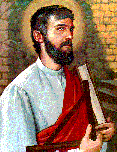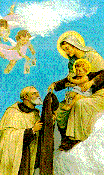|
For Major Feasts for early August, see EARLY AUGUST
For Major Feasts from June, see JUNE

  Feast of Saint Thomas the Apostle
Feast of Saint Thomas the Apostle
Tuesday, July 3, 2001
Though Saint Thomas the Apostle is often referred to as the "Doubting Apostle," in truth he was one of the most faithful, believing of Christ's disciples. This is confirmed in John 11: 16 when Thomas boldly encourages his fellow apostles to go with Jesus to Lazarus where the fear was that they might be stoned, "Let us also go, that we may die with Him." That does not display doubt, but rather undying faith. But Thomas, being human and having withered the many storms Christ underwent, expressed the sentiment many would. In other words, it was almost too much to believe that Jesus had risen. To allay any further sorrow, Thomas put up a defense to the other Apostles with his famous, "Unless I see in his hands the print of the nails, and put my finger into the place of the nails, and put my hand into his side, I will not believe." In other words, "don't tease me!" Christ understood and was gentle with Thomas, rebuking him mildly in John 20: 27-29 with "...and be not unbelieving, but believing...Because thou hast seen Me, thou has believed. Blessed are they who have not seen, and yet have believed." The last sentence is a great lesson in faith for the majority of us have not seen, yet we believe. That's faith. This event also occurred before the Descent of the Holy Spirit. Even before this Thomas had pledged his undying loyalty with his famous response to Our Lord in John 20: 28, "My Lord and my God!" It was Thomas' way of asking forgiveness for doubting. After Christ's Ascension Thomas was sent to preach in Parthia and the Indies where he gained the glorious crown of martyrdom. In 1972 Pope Paul VI proclaimed him "Patron Saint of India."

  Feast of Saint Benedict, Abbot and Religious Founder
Feast of Saint Benedict, Abbot and Religious Founder
Wednesday, July 11, 2001
Known as the "Father of Western Monastic Life," Saint Benedict is the founder of the Benedictines. Born in 480 into a noble family in the village of Nursia, Italy, he studied in Rome but, fearing he would succumb to the licentious life of his peers, left it all behind in 500 to embrace the monastic life. He retreated to the deserted mountain area of Subiaco where, guided by the Holy Spirit, he took up residence in a deep and remote cave. There he remained for three years many times depending on God's providence for food as crows would bring him bread. The only human contact he had for three years was with the holy monk Romanus who brought him food, water and simple clothing. Despite his solitude, the fame of his holiness spread far and wide, drawing many disciples to Subiaco. To minister to them Benedict founded a colony of monks and, with their help, built 12 monasteries at Subiaco. He also summoned his blood sister Saint Scholastica to help and she established numerous monasteries for nuns there to accommodate the women who wished to follow Benedict.
The strictness of this holy abbot's rule and the vice of jealousy played a role in rebellion by some monks who
conspired to poison Benedict. One of the conspirators mixed poison into Benedict's drink bowl. As was his
custom, Benedict always blessed anything before he ate it. As he made the sign of the cross over the bowl it
broke into pieces and the poison spilled harmlessly into the wood. Those monks who had planned this
dastardly deed repented, seeing the hand of God in the event. Shortly after, Benedict moved south to
Montecassino where he founded the great abbey there which stood until World War II. There also he composed
the bible of monastic life - the "Rule of St. Benedict" which has become the standard legislation for monastic life
for religious men and women in the western world. Benedict held the personal love of Christ paramount for all
with an emphasis on humility and prudence. His motto was Ora et labora, "Pray and work" with the insignia of a
cross and a plough. He was renowned for many, many miracles and knew six days before that he was going to
die. On March 21, 543 he asked his fellow monks to carry him to the abbey sanctuary where, after having
received the Body and Blood of Christ in Holy Communion, held his arms high toward Heaven and calmly left
this earth with a prayer on his lips.

  Feast of Our Lady of Mount Carmel
Feast of Our Lady of Mount Carmel
Monday, July 16, 2001
This feast dates back to the time of the Old Testament for Carmel is the mountain of the renewal of the
Covenant and Divine intervention through Elijah the Prophet around 900 BC as revealed in Isaiah, Jeremiah and 1 Kings. Carmel, which lies on the border between Samaria and Galilee 20 miles from Nazareth, is derived from the Hebrew Karem el which means garden or orchard and vine of God. It has become a symbol of grace and that is why it so so fitting that the rain Elijah [Elias] prayed for came at Carmel as the "little cloud" (3 Kings 18: 44) turned into a mighty rain that wiped out the drought. So also in the New Covenant God sent "a little cloud" in the person of His Blessed Mother Mary to rain upon mankind the graces God bestows as the Mediatrix of all graces. In the 5th Century, Chrysippus of Jerusalem wrote of the Blessed Virgin, "Hail, Cloud of Rain that offers drink to the souls of the Saints." It was around the 12th Century that Carmel first became a place of veneration toward the Mother of God and monks took up sanctuary there living a holy rule. It was the beginning of the Carmelite Order founded in the Holy Land in 1154 by Saint Berthold and dedicated to the Blessed Virgin Mary. Their original name was Brothers of the Blessed Virgin Mary of Mount Carmel. The original rule was set down by the Latin Patriarch of Jerusalem in 1209. The Crusades were instrumental in bringing the Carmelites to Europe through the work of Saint Simon Stock whose feast this date the Church formally celebrated. This English monk learned through private revelation of locutions and visions from Our Lady that he was to join an order not known in Britain, yet dedicated to her, and was asked to wait until a few White Friars, as they were called, came to England with the returning Crusaders. Then he was guided to join this Order of Our Lady of Mount Carmel. Because of his holiness and reverence and, because of the Providence of God through Our Lady, Simon was chosen the Prior-General of the Order at Aylesford, England in 1245. But it wasn't to be easy. Many persecutions arose against the Carmelites and always Simon went in filial obedience to Our Lady for consolation and direction. This led him to the famous apparition at the White Friar's convent in Cambridge, England on July 16, 1251 in which Our Lady appeared to him, presenting him with the Brown Scapular as an outward sign of protection, telling Simon, "Here is the privilege that I grant to you and to all the children of
Carmel, whoever dies clothed in this habit shall be saved." Many miracles ensued and the Brown Scapular
became legendary as miraculous protection for all who wore it and it spread rapidly through the centuries.
Though it is not "magical" and one must be in a state of grace to receive the merits inherent in wearing the
Scapular, it is another sign of God's infinite Mercy that He is with us always. The granting of the Scapular gave
Simon the fortitude to reorganize the Carmelites into mendicant friars similar to the Franciscans which had
begun a few decades prior. Simon died at Bordeaux in 1265 while evangelizing and establishing more
Carmelite houses in France. The feast of St. Simon Stock and Our Lady of Carmel were first introduced into the
Church in the late 1370's in commemoration of Pope Honorius III's approval of the Carmelite Rule. Over the next several centuries laxity set in and it wasn't until the 16th Century that Saint Theresa of Avila and Saint John of the Cross reformed the Order, setting up two branches for both men and women: the Discalced and Calced. One branch was dedicated to contemplative, devoting themselves in prayers of intercession for the other branch of Carmelites who were active in the world in missionary activities. In 1726 Pope Benedict XIII introduced this feast into the Roman Calendar. The Carmelites' ideal became world-famous through the 1925 canonization of "the Little Flower" - Saint Theresa of Lisieux (1873-1897) by Pope Pius XI. Yes, the "little rain cloud" personified through Our Lady has brought the reign of God to countless millions through the Providence of Carmel.

  Feast of the Apostle Saint James the Greater
Feast of the Apostle Saint James the Greater
Wednesday, July 25, 2001
Known as Saint James the Greater because he was called to be an Apostle before the other James, he was also the older brother of Saint John the Evangelist who were sons of Zebedee and Salome. He followed his brother John to the shores of the Jordan River where he was called by Jesus to be "fishers of men." James was one of the three privileged Apostles, along with Peter and John, to witness three miraculous events - the healing of Peter's mother-in-law (cf Matthew 1: 29-31), resurrection of the daughter of Jairus (cf. Mark 5: 37-43) and the Transfiguration of Jesus (cf. Mark 9: 2-8). James was also present in the agony of Garden as one of the few apostles who accompanied Jesus there and fell asleep. Jesus affectionately called James a "son of thunder" because of his great flaming love of his soul for the Son of God. James revealed his humanity in Luke 9: 51-56 when James impetuously railed about calling down fire from Heaven on the Samaritans because of their lack of faith and in the famous scene in Mark 10: 35-45 where the two brothers ask Jesus for the privilege of sitting at His right side in Heaven. But after Pentecost all imperfections faded and James went on to preach the Gospel in Samaria and Judea, then traveled a great distance to Spain where he evangelized. In Zaragosa, Spain around 40 AD the Blessed Mother made her first recorded apparition, this before her Assumption, appearing to James in a vision as Our Lady of Pilar because she stood on a pillar with the angels supporting it. Her purpose was to summon him back to Jerusalem where he was martyred by beheading at the hands of Herod Agrippa around 43 AD. He was buried in Jerusalem but his relics were transfered to Compostela, Spain in 830 where they remain today.

  Feast of Saint Joachim and Anne, Parents of Our Lady
Feast of Saint Joachim and Anne, Parents of Our Lady
Thursday, July 26, 2001
The apocryphal Protoevangelium of St. James claims that the parents of the Blessed Virgin Mary, Saint Joachim and Saint Anne were sterile, yet an angel predicted Mary's birth to Joachim after he had spent 40 days in the desert fasting and praying. Anne was too old by biological standards to give birth, but God in His Providence miraculously allowed Anne to be impregnated with the wondrous Immaculate Conception. At Mary's birth she was given the name Miriam which was shortened to Mary and, at a very early age, Joachim and Anne consecrated her to God sending her off to the Temple to study and live her Hebrew faith. St. Anne or Ann, which means "grace," was, along with Joachim, given special graces for their faithfulness, and the greatest grace was that they were chosen to be the parents of the Mother of God and the grandparents of Jesus, Son of God. St. Anne is considered the patron of mothers and of special importance to children and she is greatly venerated in Canada, specifically at the massive St. Anne Beaupre Basilica in Quebec. At first St. Anne was the only one recognized in the Church dating back to the crusades, but St. Joachim was added in 1584 by Pope Gregory XIII and the two feasts were combined into one day; originally this was March 20, the day after the feast of St. Joseph, but in 1969 the Church, through recommendation of the Second Vatican Council, moved the date to July 26th.

  Feast of Saint Ignatius of Loyola, Religious Founder
Feast of Saint Ignatius of Loyola, Religious Founder
Tuesday, July 29, 2001
The founder of the Society of Jesus, better known as the Jesuits, was born in Guipuzcoa, Spain in 1491, the youngest of eleven children. Saint Ignatius Lopez of Loyola did not realize what great mission God had in store for him until, while recovering from a battle injury at Pamplona in 1521, he began reading "The Life of Christ" by Ludolph of Saxony. It was during this time that two people came into his life that would alter the course of history and his life forever. First, the heresy of the monk Martin Luther who Ignatius realized had to be thwarted; and secondly, through prayer for direction, Our Lady appeared to him in a vision requesting he make a pilgrimage to Montserrat where the famous Madonna statue resided at the Benedictine Abbey. Shortly after she imparted the the idea of his now famous and simple Spiritual Exercises which he made a first draft of in 1522. His life would reflect the course of the Jesuits which he was about to found. After a pilgrimage to Jerusalem, he returned to study Latin at the University of Alcala in Spain but was imprisoned on the false charges of being an illuminist. He fled to Salamanca where again he was prosecuted through a kangaroo court and jailed. Freed seven years later, he journed to Paris where he completed his studies. Then in 1534, four years after the Diet of Augsburg, Ignatius gathered six companions including his friend Saint Francis Xavier in the chapel at Montmartre to form the Society of Jesus, vowing poverty and chastity, and offering themselves to the Holy Father as he wished to use them. Though they had intended to go to the Holy Land to preach the Gospel, political circumstances prevented this journey. It was to be providential as Ignatius was ordained in 1538 and two years later the Jesuits were approved by Pope Paul III in his papal bull Regimini Militantes Ecclesiae. Raised to be a soldier, Ignatius truly became a "soldier of Christ" as did his Order of which he became the first Superior General in 1551, a year after the definitive Constitution of the Jesuits had been approved by Pope Jules III. During a general meeting of the Society in 1556, Ignatius, at the age of 65, passed away peacefully. From the beginning the Jesuits had dedicated their ministry to defending the Pope and fighting the heresies that threatened Holy Mother Church. While Martin Luther was effecting millions of defectors from Holy Mother Church, God raised up a man who would conversely convert millions more through his Society's commitment of imparting thorough knowledge of the One, True Faith.
|





